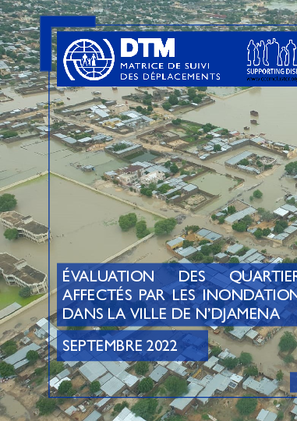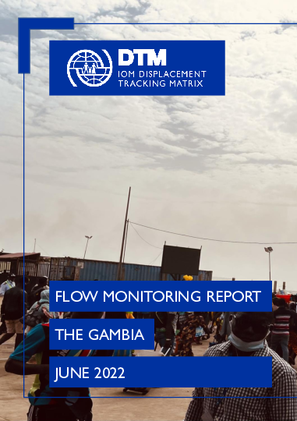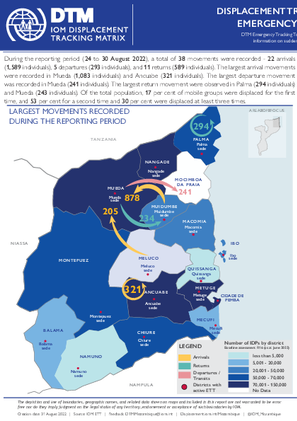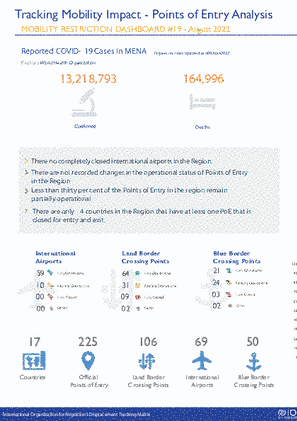-
Countries
-
Data and Analysis
-
Special Focus
-
Crisis Responses

Contact
DTM Sudan; dtmsudan@iom.int
Language
English
Location
Sudan
Snapshot Date
Aug 31 2022
Activity
- Mobility Tracking
- Event Tracking
The DTM Emergency Event Tracking (EET) is deployed to track sudden displacement and population movements, provide more frequent updates on the scale of displacement, and quantify the affected population when needed. As a subcomponent of the new Mobility Tracking methodology in Sudan (Round Four), and activated on a need basis, EET utilises a broad network of key informants to capture best estimates of the affected population presence per location – a useful tool for humanitarian response planning and design.

Contact
DTM Chad, dtmtchad@iom.int
Language
French
Location
Chad
Period Covered
Aug 30 2022
Sep 01 2022
Activity
- Survey
- Mobility Tracking
- Baseline Assessment
- Village Assessment
Les données présentées dans ce rapport ont été collectées du 30 août au 01 septembre 2022 dans 42 quartiers affectés par les inondations dans la ville de N’djamena. L’objectif est de fournir un aperçu plus ou moins complet de l’impact des inondations dans les quartiers les plus touchés de la ville de N’djamena, en procurant plus de détails sur les populations affectées, leurs profils, besoins et vulnérabilités. 42 quartiers ont été évalués et 259 ménages affectés par les inondations ont été enquêtés.
Les évaluations ont ressorti que 9 103 ménages (44 829 personnes) ont été affectés par les inondations, dont 3 825 ménages de 15 792 personnes qui se sont déplacés dans des familles d'accueil et des centres collectifs, notamment dans les écoles.
Les 1er, 7ème et 10ème arrondissement ont été les plus affectés. Au niveau des quartiers, les plus affectés ont été Harrandji 1 (situé dans le 7ème arrondissement), Ngonba (9ème arrondissement), Guinebor 1 et Ardep Timane (1er arrondissement) et Ndjari Kawas dans le 8ème arrondissement.

Contact
https:/dtm.iom.int/gambia
Language
English
Location
The Gambia
Period Covered
Jun 01 2022
Jun 30 2022
Activity
- Survey
- Flow Monitoring Survey
In order to gain a better understanding of mobility flows and trends throughout West and Central Africa, the International Organization for Migration (IOM) implements the Displacement Tracking Matrix’s Flow Monitoring (FM) tool at key transit points across the region.
In The Gambia, DTM conducts Flow Monitoring activities at several important transit locations: in 1) Barra (FMPs are located at the ferry terminal and the main garage);
2) Farafenni (FMPs are located at Farafenni main garage, Farafenni Ballan-Ghar garage, Farafenni McCarthy and Sanjally garage, Farafenni turntable garage, and the truck garage); 3) Basse (FMPs are situated at the main garage and the bus station in Basse Santa-Su) and 4) Brikama (FMPs are located at the main garage and the Bus station).
These activities enable DTM to monitor the movements of passengers within The Gambia, out of, and towards The Gambia as well as transiting The Gambia.
This report presents the key results from the Flow Monitoring Survey conducted with travelers between October and December 2021. The report presents data collected on flows, routes, provenance, destination, and demographic profiles of travelers observed at the FMPs.
Contact
DTMUkraine@iom.int
Location
Ukraine
Activity
- Mobility Tracking
- Baseline Assessment
Period Covered
Aug 22 2022 -Sep 02 2022
A baseline assessment is a sub-component of mobility tracking. It aims to collect data on IDP, migrant or returnee population presence in a defined administrative area of the country.
Population Groups
Survey Methodology
Unit of Analysis Or Observation
Type of Survey or Assessment
Keywords
Geographical Scope
Administrative boundaries with available data
The current dataset covers the following administrative boundaries
Contact
DTMUkraine@iom.int
Location
Ukraine
Activity
- Mobility Tracking
- Baseline Assessment
Period Covered
Aug 22 2022 -Sep 02 2022
A baseline assessment is a sub-component of mobility tracking. It aims to collect data on IDP, migrant or returnee population presence in a defined administrative area of the country.
This is a restricted dataset. To get access, kindly click on the 'Request Access' button.
Population Groups
IDPs
Survey Methodology
Unit of Analysis Or Observation
Admin Area 2
Type of Survey or Assessment
Key Informant
Keywords
Geographical Scope Partial Coverage
Administrative boundaries with available data
The current dataset covers the following administrative boundaries

Contact
DTMMozambique@iom.int
Language
English
Location
Mozambique
Period Covered
Aug 24 2022
Aug 30 2022
Activity
- Mobility Tracking
- Event Tracking
During the reporting period (24 to 30 August 2022), a total of 38 movements were recorded - 22 arrivals (1,589 individuals), 5departures (293 individuals), and 11 returns (589 individuals). The largest arrival movements were recorded in Mueda (1,083 individuals) and Ancuabe (321 individuals). The largest departure movement was recorded in Mueda (241 individuals). The largest return movement were observed in Palma (294 individuals) and Mueda (243 individuals). Of the total population, 17 per cent of mobile groups were displaced for the first time, and 53 per cent for a second time and 30 per cent were displaced at least three times.

Contact
DTM Sudan; dtmsudan@iom.int
Language
English
Location
Sudan
Snapshot Date
Aug 31 2022
Activity
- Mobility Tracking
- Event Tracking
The DTM Emergency Event Tracking (EET) is deployed to track sudden displacement and population movements, provide more frequent updates on the scale of displacement, and quantify the affected population when needed. As a subcomponent of the new Mobility Tracking methodology in Sudan (Round Four), and activated on a need basis, EET utilises a broad network of key informants to capture best estimates of the affected population presence per location – a useful tool for humanitarian response planning and design.

Contact
DTM Djibouti, DTMDjibouti@iom.int
Language
French
Location
Djibouti
Period Covered
Jul 01 2022
Jul 31 2022
Activity
- Flow Monitoring
Pendant le mois de juillet 2022, 20 214 mouvements ont été observés aux points de suivi des flux (Flow Monitoring Points, FMP) à Djibouti, soit une moyenne journalière de 652 mouvements. Les flux migratoires ont diminué de 10 pour cent par rapport au mois de juin 2022, pendant lequel un total de 22 363 mouvements avaient été observés. Il convient de souligner qu’en juillet 2022, les flux ont baissé par rapport aux niveaux observés pendant la période antérieure à la pandémie de COVID-19 (entre mars 2019 et mars 2020, la moyenne journalière était de 654).
Sur ces 20 214 mouvements, 2 351 (12%) ont été observés à Obock dans la région côtière de Djibouti où les migrants traversent le golfe d'Aden vers la péninsule arabique le long de ce que l'on appelle la route de l'est. Par rapport à la période de janvier à juillet 2021, les mouvements en provenance de l’Éthiopie ont fortement augmenté de 62 pour cent avec 80 141 entrées entre janvier et juillet 2022. En revanche, par rapport à juin 2022, ces mouvements ont baissé de 11 pour cent en juillet 2022. Par ailleurs, 3 723 Éthiopiens sont revenus du Yémen depuis janvier 2022. Entre juin et juillet 2022, ces retours ont fortement diminué de 44 pour cent. Cette forte diminution peut être attribuée à l’amplification des opérations de surveillance par les garde-côtes djiboutiens à Obock.

Contact
DTM Djibouti, DTMDjibouti@iom.int
Language
English
Location
Djibouti
Period Covered
Jul 01 2022
Jul 31 2022
Activity
- Flow Monitoring
In July 2022, 20,214 movements were observed at the Flow Monitoring Points (FMPs) in Djibouti, representing a daily average of 652 movements. Migration flows decreased by 10 per cent compared to the month of June 2022, during which a total of 22,363 movements had been registered. It is worth highlighting that in July 2022 migration flows have dropped below pre-COVID-19 levels (between March 2019 and March 2020, the daily average was 654).
Of these 20,214 movements, 2,351 (12%) were observed in Obock. This coastal region of Djibouti is the main gateway for migrants going to and returning from the Arabian Peninsula. Migrants regroup at congregation points in the Obock region where they then cross the Gulf of Aden on boats along what is known as the Eastern route.
Compared to the period of January to July 2021, movements from Ethiopia have increased sharply by 62 per cent with 80,141 entries between January and July 2022. However, compared to June 2022, these movements decreased by 11 per cent in July 2022. In addition, 3,723 Ethiopians have returned from Yemen since January 2022. Between June 2022 and July 2022, these returns significantly decreased by 44 per cent. This sharp decrease may be attributed to the amplified surveillance operations by the Djiboutian coast guards in Obock.
This Middle East and North Africa (MENA) report summarizes mobility restrictions at airports, land, and blue border crossing points resulting from the mitigation measures implemented in response to the COVID-19 pandemic.
